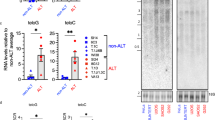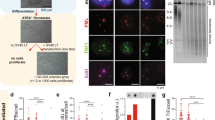Abstract
Reactivation of telomerase reverse transcriptase (TERT) expression is found in more than 85% of human cancers. The remaining cancers rely on the alternative lengthening of telomeres (ALT), a recombination-based mechanism for telomere-length maintenance. Prevalence of TERT reactivation over the ALT mechanism was linked to secondary TERT function unrelated to telomere length maintenance. To characterize this non-canonical function, we created a panel of ALT cells with recombinant expression of TERT and TERT variants: TERT-positive ALT cells showed higher tolerance to genotoxic insults compared with their TERT-negative counterparts. We identified telomere synthesis-defective TERT variants that bestowed similar genotoxic stress tolerance, indicating that telomere synthesis activity is dispensable for this survival phenotype. TERT expression improved the kinetics of double-strand chromosome break repair and reduced DNA damage-related nuclear division abnormalities, a phenotype associated with ALT tumors. Despite this reduction in cytological abnormalities, surviving TERT-positive ALT cells were found to have gross chromosomal instabilities. We sorted TERT-positive cells with cytogenetic changes and followed their growth. We found that the chromosome-number changes persisted, and TERT-positive ALT cells surviving genotoxic events propagated through subsequent generations with new chromosome numbers. Our data confirm that telomerase expression protects against double-strand DNA (dsDNA)-damaging events, and show that this protective function is uncoupled from its role in telomere synthesis. TERT expression promotes oncogene-transformed cell growth by reducing the inhibitory effects of cell-intrinsic (telomere attrition) and cell-extrinsic (chemical- or metabolism-induced genotoxic stress) challenges. These data provide the impetus to develop new therapeutic interventions for telomerase-positive cancers through simultaneous targeting of multiple telomerase activities.
This is a preview of subscription content, access via your institution
Access options
Subscribe to this journal
Receive 50 print issues and online access
$259.00 per year
only $5.18 per issue
Buy this article
- Purchase on Springer Link
- Instant access to full article PDF
Prices may be subject to local taxes which are calculated during checkout






Similar content being viewed by others
References
Egan ED, Collins K . Biogenesis of telomerase ribonucleoproteins. RNA 2012; 18: 1747–1759.
Hukezalie KR, Wong JM . Structure-function relationship and biogenesis regulation of the human telomerase holoenzyme. FEBS J 2013; 280: 3194–3204.
Cong YS, Wright WE, Shay JW . Human telomerase and its regulation. Microbiol Mol Biol Rev 2002; 66: 407–425.
Wright WE, Piatyszek MA, Rainey WE, Byrd W, Shay JW . Telomerase activity in human germline and embryonic tissues and cells. Dev Genet 1996; 18: 173–179.
Fleisig HB, Wong JM . Telomerase as a clinical target: current strategies and potential applications. Exp Gerontol 2007; 42: 102–112.
Wong JM, Collins K . Telomere maintenance and disease. Lancet 2003; 362: 983–988.
Shay JW, Bacchetti S . A survey of telomerase activity in human cancer. Eur J Cancer 1997; 33: 787–791.
Bodnar AG, Ouellette M, Frolkis M, Holt SE, Chiu CP, Morin GB et al. Extension of life-span by introduction of telomerase into normal human cells. Science 1998; 279: 349–352.
Martinez P, Blasco MA . Telomeric and extra-telomeric roles for telomerase and the telomere-binding proteins. Nat Rev Cancer 2011; 11: 161–176.
Gorbunova V, Seluanov A, Pereira-Smith OM . Expression of human telomerase (hTERT) does not prevent stress-induced senescence in normal human fibroblasts but protects the cells from stress-induced apoptosis and necrosis. J Biol Chem 2002; 277: 38540–38549.
Sharma GG, Gupta A, Wang H, Scherthan H, Dhar S, Gandhi V et al. hTERT associates with human telomeres and enhances genomic stability and DNA repair. Oncogene 2003; 22: 131–146.
Masutomi K, Possemato R, Wong JM, Currier JL, Tothova Z, Manola JB et al. The telomerase reverse transcriptase regulates chromatin state and DNA damage responses. Proc Natl Acad Sci USA 2005; 102: 8222–8227.
Tamakawa RA, Fleisig HB, Wong JM . Telomerase inhibition potentiates the effects of genotoxic agents in breast and colorectal cancer cells in a cell cycle-specific manner. Cancer Res 2010; 70: 8684–8694.
Bryan TM, Englezou A, Dalla-Pozza L, Dunham MA, Reddel RR . Evidence for an alternative mechanism for maintaining telomere length in human tumors and tumor-derived cell lines. Nat Med 1997; 3: 1271–1274.
Fasching CL, Bower K, Reddel RR . Telomerase-independent telomere length maintenance in the absence of alternative lengthening of telomeres-associated promyelocytic leukemia bodies. Cancer Res 2005; 65: 2722–2729.
Fleisig HB, Wong JM . Telomerase promotes efficient cell cycle kinetics and confers growth advantage to telomerase-negative transformed human cells. Oncogene 2012; 31: 954–965.
Perrem K, Colgin LM, Neumann AA, Yeager TR, Reddel RR . Coexistence of alternative lengthening of telomeres and telomerase in hTERT-transfected GM847 cells. Mol Cell Biol 2001; 21: 3862–3875.
Armbruster BN, Etheridge KT, Broccoli D, Counter CM . Putative telomere-recruiting domain in the catalytic subunit of human telomerase. Mol Cell Biol 2003; 23: 3237–3246.
Ulaner GA, Hu J, Vu TH, Giudice LC, Hoffman AR . Telomerase activity in human development is regulated by human telomerase reverse transcriptase (hTERT) transcription and by alternate splicing of hTERT transcripts. Cancer Res 1998; 58: 4168–4172.
Yi X, White DM, Aisner DL, Baur JA, Wright WE, Shay JW . An alternate splicing variant of the human telomerase catalytic subunit inhibits telomerase activity. Neoplasia 2000; 2: 433–440.
Listerman I, Sun J, Gazzaniga FS, Lukas JL, Blackburn EH . The major reverse transcriptase-incompetent splice variant of the human telomerase protein inhibits telomerase activity but protects from apoptosis. Cancer Res 2013; 73: 2817–2828.
Lovejoy CA, Li W, Reisenweber S, Thongthip S, Bruno J, de Lange T et al. Loss of ATRX, Genome Instability, and an Altered DNA Damage Response Are Hallmarks of the Alternative Lengthening of Telomeres Pathway. PLoS Genet 2012; 8: e1002772.
Fenech M . Cytokinesis-block micronucleus cytome assay. Nat Protoc 2007; 2: 1084–1104.
Fu D, Collins K . Purification of human telomerase complexes identifies factors involved in telomerase biogenesis and telomere length regulation. Mol Cell 2007; 28: 773–785.
Okamoto N, Yasukawa M, Nguyen C, Kasim V, Maida Y, Possemato R et al. Maintenance of tumor initiating cells of defined genetic composition by nucleostemin. Proc Natl Acad Sci USA 2011; 108: 20388–20393.
Park JI, Venteicher AS, Hong JY, Choi J, Jun S, Shkreli M et al. Telomerase modulates Wnt signalling by association with target gene chromatin. Nature 2009; 460: 66–72.
Lincz LF, Mudge LM, Scorgie FE, Sakoff JA, Hamilton CS, Seldon M . Quantification of hTERT splice variants in melanoma by SYBR green real-time polymerase chain reaction indicates a negative regulatory role for the beta deletion variant. Neoplasia 2008; 10: 1131–1137.
Robin JD, Ludlow AT, Batten K, Magdinier F, Stadler G, Wagner KR et al. Telomere position effect: regulation of gene expression with progressive telomere shortening over long distances. Genes Dev 2014; 28: 2464–2476.
Bryant HE . DNA double-strand break damage and repair assessed by pulsed-field gel electrophoresis. Methods Mol Biol 2012; 920: 315–321.
Poon SS, Lansdorp PM . Measurements of telomere length on individual chromosomes by image cytometry. Methods Cell Biol 2001; 64: 69–96.
Acknowledgements
We thank members of Judy Wong’s laboratory for providing helpful insights. Kathleen Collins and Bill Hahn kindly provided reagents. Shirley Yeung, Irene Iu and Arthur Chan assisted with method development. Nigel O’Neil assisted with optimization of the chromosomal healing assay. Andy Johnson from the UBC Flow-Cytometry Facility provided expertise with FACS procedures. We thank them for their assistance. Financial support for this work was provided by the Canadian Cancer Society Research Institute (operating grant #019250), and Research Reinvestment Funds from the Faculty of Pharmaceutical Sciences at UBC. JMYW is supported by the Michael Smith Foundation for Health Research Career Development program.
Author information
Authors and Affiliations
Corresponding author
Ethics declarations
Competing interests
The authors declare no conflict of interest.
Additional information
Supplementary Information accompanies this paper on the Oncogene website
Rights and permissions
About this article
Cite this article
Fleisig, H., Hukezalie, K., Thompson, C. et al. Telomerase reverse transcriptase expression protects transformed human cells against DNA-damaging agents, and increases tolerance to chromosomal instability. Oncogene 35, 218–227 (2016). https://doi.org/10.1038/onc.2015.75
Received:
Revised:
Accepted:
Published:
Issue Date:
DOI: https://doi.org/10.1038/onc.2015.75
This article is cited by
-
Exploiting TERT dependency as a therapeutic strategy for NRAS-mutant melanoma
Oncogene (2018)
-
Chromosomal disruption and rearrangements during murine sarcoma development converge to stable karyotypic formation kept by telomerase overexpression
Journal of Biomedical Science (2016)
-
hTERT promotes cell adhesion and migration independent of telomerase activity
Scientific Reports (2016)



